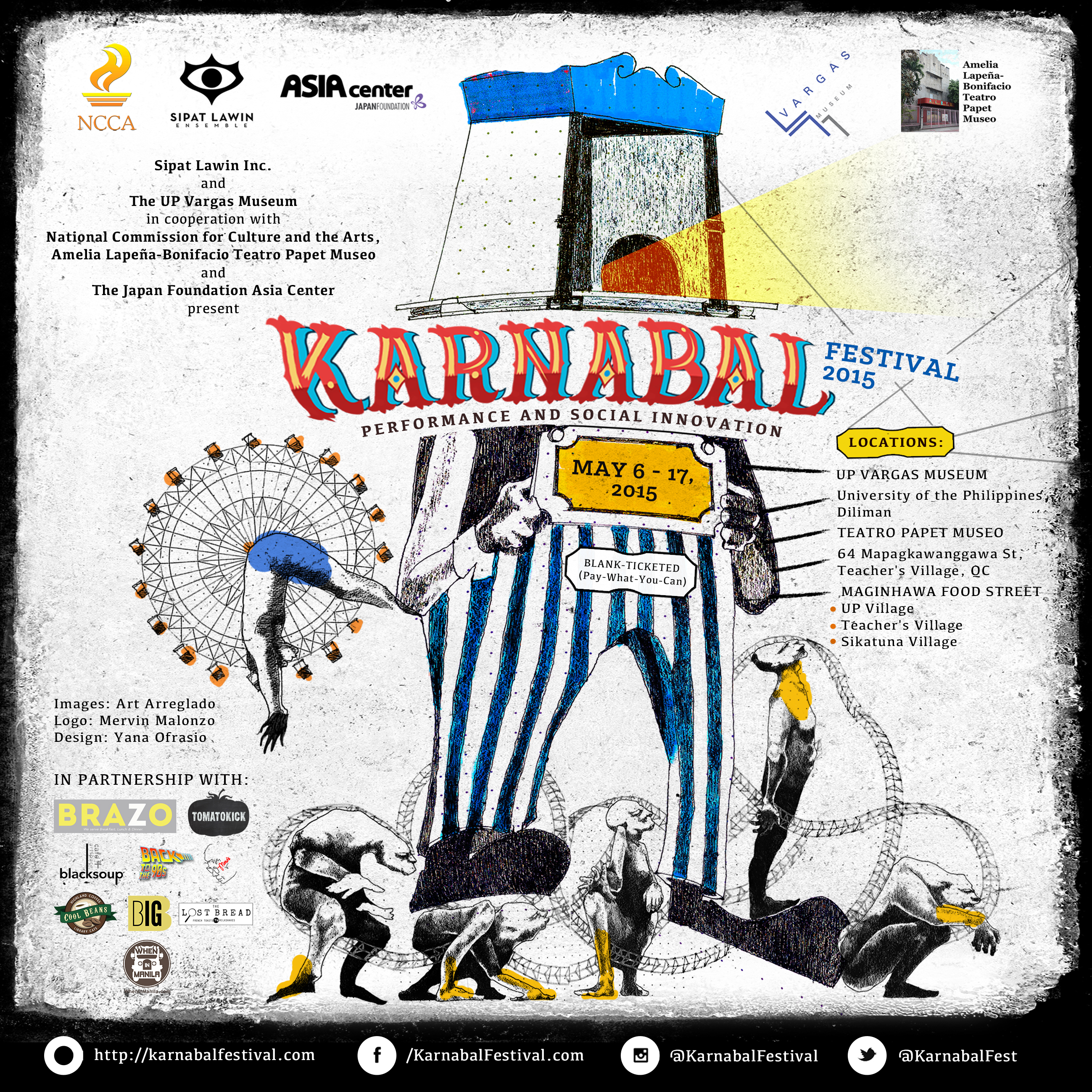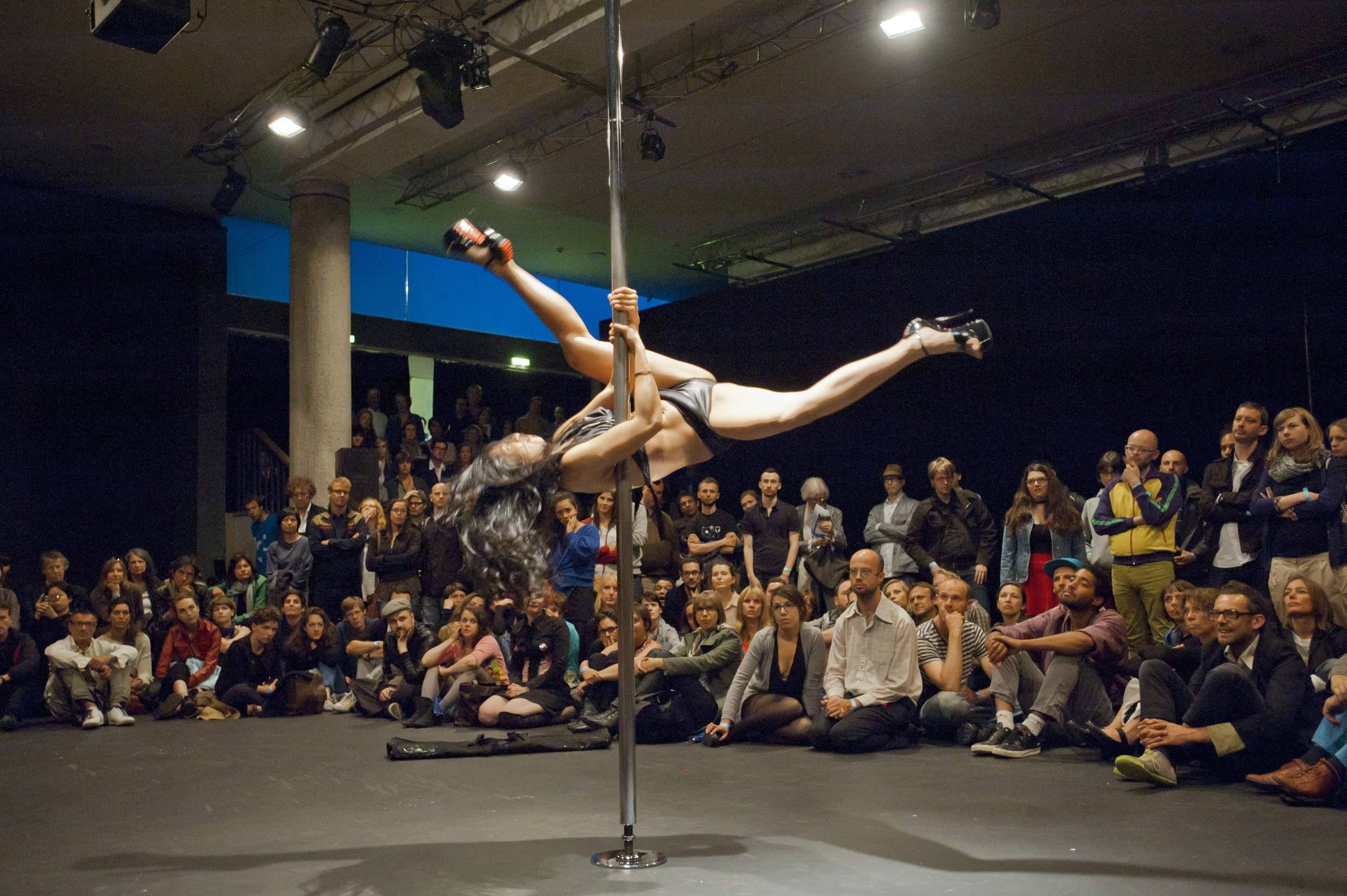The Next Piece Gobyerno and the Ideal Government
JK: Our next piece is called Gobyerno, which means government.
Yamaguchi: It is invited to Festival Bo:m in Seoul. Congratulations.
JK: Thank you. I met the festival director Lee Seunghyo in Melbourne. Gobyerno will be presented as a prototype in Festival Bo:m, and David joins to show it in Manila in May. It is a participatory work where audience performs and shoots a film about the ideal government. We ask the audience what the ideal government that they imagine is like. They enter an auditorium like a set for a film, and shoot a film about policies, politics, whether to have a female leader or a male leader, whether to have a parliamentary system or something else. There are artists, designers and performers who move as you want them to, so you can make your own film. The idea is to have them propose the ideal lifestyle. Of course, their ideas of the ideal government are also important. It's easy to think about that, but it's not easy to perform the ideas. The performance becomes a rehearsal for possibilities, for revolution.
Ideal Environment for Creation that Karnabal Festival Pursues
Yamaguchi: What kind of festival is Karnabal?
Sarah: Karnabal started in 2013, and I am one of the curators. The first edition gathered artists who are active or emerging in the alternative, contemporary performing arts scene from various fields, and aimed to be a platform for their presentations. Most of these artists cannot be categorized or classified. For example, what Sipat Lawin does is considered by some as performance art, not theatre, so we are not regarded as a theatre company, and there are communities and situations that do not accept what we do as performance art. Also, if a shadow play collective applies for a grant for theatre, they are told that what they do is visual art... Karnabal is an open festival that hosts such works and artists. There are diverse people doing diverse activities, but they don't really know each other. We established Karnabal to have them get to know each other and to share audiences and resources, and we presented 15 to 20 pieces.

Yamaguchi: That is quite a number.
Sarah: Yes. We sent a call out to different artists, including student theatre companies. It will be held from May 6th to 17th this year. The curatorial policy will be a little different, with a focus not only on shows but also on process and development.
JK: Sarah and I have been talking with the artists and asking them to deliver ideas and proposals for change of performance and society. Our own practice and experience have shown that the methodology of creation shifts if you consider audience a part of creation process and have specific communities and people in your mind. It is OK to think that you are an artist who can rehearse as you like to do and don't care about who are watching you. However, if you want to approach teenagers through Twitter, for example, you need to use their language and your creation methodology changes. We are asking the artists to conceive pieces as proposals. We have received a lot of advices from Eisa, who has been internationally active.
Seen from the Outside of the Philippines
Yamaguchi: Thank you, Eisa, for joining us this early in the morning. How did you get to know JK?
Eisa Jocson (hereinafter Eisa): I met him for the first time 12 years ago. We went to the same high school. He was in the theatre department and I was in fine arts, there is something common, in synchronicity, in the paths we took after that.

Eisa: I was working on the creation of Death of the Pole Dancer in 2011, the same year when Battalia Royale started. We have gone through a lot of similar experiences to become artists, and since we lived in the same house, we exchanged ideas frequently. For me the house was a place where new things would emerge, and it is important for me to maintain that kind of place, which is significant for people working in the performing arts sector and potentially paradigm-shifting. It is important especially for young artists.
JK: I think so too. It's hard to do though.
Eisa: The attempts of Sipat Lawin are also effective. I have always been working as an individual, mostly outside, so I value the opportunity for balancing the internal and external gazes and receiving feedbacks. When I come back to Manila after a long absence, I feel there is no place for me to be, but by meeting people that I know, seeing their shows or just taking part in a discussion, I can learn about what is going on and that pulls me back to the ground.
JK: We want to have Eisa's works take root in the performing arts scene of Manila. She has advised us to be able to work in the international theatre scene, and taught us how important contexts are.

Sarah: A place for exchange is really important.
Eisa: Yes. A place for talking, discussing, working and opening. Probably we haven't really stated what we think in the Philippines. Even if you want to say what you feel, you can't do that well without education and experience. Education is based on the environment, and the environment can improve very much if experienced people offer feedbacks and critique.
Sarah: As a curator of Karnabal, I would like to support artists in the process of their new creations by offering them feedbacks and comments and to facilitate communication between the artists.
Eisa: That is exactly what is needed. The fact that we are talking like this here is impressive. There are many platforms and residencies in Brussels, where I can hear from a lot of people during a creation process, show a work-in-progress, and receive feedbacks. I can propose my concept, have a residency next year, and take time to cultivate the concept before starting to work. In the Philippines, it is almost impossible to have a long-term plan for creating a piece. You just make it and show it. There is no platform for thinking.
JK: The necessity of that kind of place has to be more widely acknowledged. Last night, I saw the rehearsal of Eisa's work-in-progress Host. It is not a show but a presentation of a work-in-progress.
Eisa: There is no such luxury in the Philippines.
Sarah: Sipat Lawin's pieces are all prototypes of something. If we call them productions, audience will expect something more than prototypes. On the other hand, we can't ask them to pay for something incomplete. We need to find the balance between these two poles.
JK: I think it is good to have a room for failure. You can fail before completing a piece. We can communicate something to young artists through failure, and we can also offer our small space to them. We can launch many projects thanks to the base, and Sipat Lawin will be active at least for a few more years.
Yamaguchi: It is interesting that artists themselves have been trying to build such platforms.
Eisa: Every time I come back to Manila from abroad, I find that the artist community has grown, which encourages me very much. I am a part of it, but I usually see it from the outside. Whenever I come back, the community has obviously evolved. Sarah has changed very much too. When I first met her, she was like an assistant to JK or me, but now she is an independent individual who has her own principles. Sipat Lawin has gradually been building international network, and the results of their exchange are beginning to surface. If we keep proceeding like this, there will be a break-through in the performing arts scene in the Philippines.
On International Collaboration
Yamaguchi: What do you think about collaboration with artists of other countries?
Sarah: There are a lot of festivals that present productions in Manila too, and they call themselves "international festival" and highlight artists that they invite from other countries. There is a tendency to praise everything that comes from abroad in the Philippines, and the exchange doesn't continue. Karnabal wants to deepen the exchange with artists from other cultural spheres as an international platform this time, to establish a foothold for international collaboration. The festival can be called a platform for exchange.
JK: Foreign artists visit the Philippines, meet artists of the Philippines, see their shows and understand the situation. We will propose a plan before the end of the festival, and try to carry it out in 2016 as a pilot project. We have been applying for grants for that, and the artists to be invited have also been trying to fundraise.
Yamaguchi: I hope Japanese artists will contribute something too.
JK: Yes. I look forward to meeting Japanese artists, who are interested in taking part in Karnabal and involving themselves in the performances and communities, at TPAM (Performing Arts Meeting in Yokohama).
Sarah: We also want to meet artists from the ASEAN countries here.
Eisa: The performing arts sector in the Philippines is isolated from the international network, so it is very difficult even to meet with artists of the neighboring countries. So I hope they will be able to involve many Southeast Asian artists. We feel that we are closer to the West, probably because of the education.
Sarah: We don't know the situation of performing arts in other Southeast Asian countries, and I suppose the situation of the Philippines is not known either. There hasn't been real exchange. Traditional dance and theatre have been known, but there is very little exchange in contemporary performing arts.
Yamaguchi: Today's Group Meeting at TPAM is a good opportunity.
JK: We've been cheered up here. Patience is the most important thing! I feel that now is the time for us to really engage in theatre and performance.
Sarah: And to be artists.
JK: Right. TPAM gives us energy for thinking, and it must be very good for artists who work in Manila to know that there are international communities.
Sarah: Yesterday I talked with Helly Minarti from Jakarta Arts Council, and heard about the difficulty to engage in performing arts in her country. I talked about the situation of the Philippines too, and it was somehow encouraging to learn that it is not only us who are in similar difficult situations which spur ideas and efforts that can lead us to creative wayfinding.
Yamaguchi: Thank you for the conversation. I was encouraged too.
JK: Thank you very much.
Sarah: Let's eat something together when you visit the Philippines.
JK: And let's dance!

[February 15, 2015, in Sakuragicho, Yokohama]
Interviewer: Makiko Yamaguchi (Japan Foundation)
After working on Japan–Germany cultural exchange through music, theatre, dance and photography at Goethe-Institut Tokyo, she organized projects for performing arts exchange, promotion of Japanese culture and information exchange at the Japanese Culture Institute in Köln (The Japan Foundation). From spring 2011, she was in charge of the networking program at Tokyo Culture Creation Project Office (Tokyo Metropolitan Foundation for History and Culture). Currently works at The Japan Foundation Asia Center.






